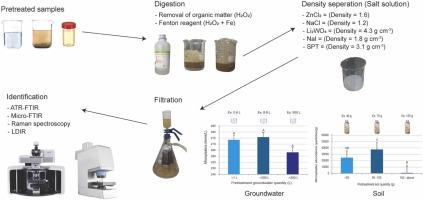优化土壤、地下水和人体样品中微塑料的收集、预处理、提取、分离和检测方法
IF 11.3
1区 环境科学与生态学
Q1 ENGINEERING, ENVIRONMENTAL
引用次数: 0
摘要
土壤、地下水和人体(SGH)中的微塑料(MPs)因其对生态和人类健康的影响而成为一项重大的全球性挑战。然而,目前在这些环境和人体中检测 MPs 的方案有限,应用不一致,而且差异很大,尤其是在 MP 分析的预处理阶段。此外,还没有研究调查过方法缺陷对 MP 检测的影响。本研究对现有的土壤和地下水 (SG) 预处理方法进行了全面评估,并使用统计测试来评价其有效性。研究还审查了 SGH 样品中 MP 的过滤和分析技术。分析包括 2015 年至 2024 年间发表的来自 PubMed、Google Scholar、Scopus 和 Web of Science 的研究文章。研究结果表明,使用超过 100 克的土壤进行预处理会影响 MP 的定量,这可能是由于土壤的异质性造成的,而地下水的体积对 MP 的定量没有显著影响,这可能是由于地下水的均质性造成的。在 SGH 预处理过程中,可使用各种盐类(如 ZnCl2 和 NaCl)进行密度浮选。在去除有机物方面,芬顿试剂比 H2O2 更好,因为释放的热量更少。处理后的 SGH 样品中的 MPs 可使用各种仪器和分辨率进行分析,例如傅立叶变换红外光谱(FTIR)可达 1-5 µm,ATR-FTIR 可达 2 µm,微拉曼光谱可达 500 nm,LDIR 可达 1 µm。这项研究为开发有效的 SGH MP 分析奠定了基础。本文章由计算机程序翻译,如有差异,请以英文原文为准。

Methods to optimize the collection, pretreatment, extraction, separation, and examination of microplastics in soil, groundwater, and human samples
Microplastics (MPs) in soil, groundwater, and human (SGH) present a significant global challenge due to their ecological and human health impacts. However, current protocols for detecting MPs in these environments and humans are limited, inconsistently applied, and vary significantly, particularly during the pretreatment stages of MP analysis. Moreover, no study has investigated the impact of methodological flaws on MP detection. This study conducted a thorough global assessment of the existing soil and groundwater (SG) pretreatment methods, using statistical tests to evaluate their effectiveness. It also reviewed filtration and analytical techniques for MPs in SGH samples. The analysis included research articles from PubMed, Google Scholar, Scopus, and Web of Science published between 2015 and 2024. Findings show that pretreatment using more than 100 g of soil can impact MP quantification, likely due to soil heterogeneity, while groundwater volume did not significantly affect MP quantification, likely due to the homogeneity of groundwater. During SGH pretreatment, various salts (e.g., ZnCl2 and NaCl) can be used for density flotation. Fenton's reagent was found to be a better choice than H2O2 for organic material removal because less heat was released. Post treatment MPs in SGH samples can be analyzed using various instruments and resolutions such as FTIR down to 1-5 µm, ATR-FTIR down to 2 µm, micro-Raman down to 500 nm, and LDIR down to 1 µm. This study lays the foundation for developing an effective MP analysis in SGH.
求助全文
通过发布文献求助,成功后即可免费获取论文全文。
去求助
来源期刊

Journal of Hazardous Materials
工程技术-工程:环境
CiteScore
25.40
自引率
5.90%
发文量
3059
审稿时长
58 days
期刊介绍:
The Journal of Hazardous Materials serves as a global platform for promoting cutting-edge research in the field of Environmental Science and Engineering. Our publication features a wide range of articles, including full-length research papers, review articles, and perspectives, with the aim of enhancing our understanding of the dangers and risks associated with various materials concerning public health and the environment. It is important to note that the term "environmental contaminants" refers specifically to substances that pose hazardous effects through contamination, while excluding those that do not have such impacts on the environment or human health. Moreover, we emphasize the distinction between wastes and hazardous materials in order to provide further clarity on the scope of the journal. We have a keen interest in exploring specific compounds and microbial agents that have adverse effects on the environment.
 求助内容:
求助内容: 应助结果提醒方式:
应助结果提醒方式:


